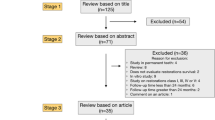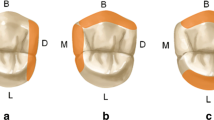Abstract
The aim of this study was to compare the treatment results using four different types of tooth colored materials for restoring class V lesions. A total of 197 class V restorations (n=197) were placed by one dentist in 37 patients on incisors, canines and premolars. The fillings were placed due to different indications: erosion/non-carious cervical defects (n=69), primary carious lesions (n=57), and for replacing defective existing fillings (n=71). The teeth were assigned on a random basis to four groups for restoration with either a composite (group 1: n=36; Tetric, Vivadent), or a polyacid-modified resin composite (group 2: n=79; Dyract, Dentsply), or one of two different resin-modified glass ionomer cements (group 3: n=51, Fuji II LC,GC; group 4: n=31, Photac-Fil, Espe). The restorations were evaluated by a single-blind design, according to a modified USPHS system 36 months following placement. Statistical analysis was completed with the Pearson Chi-square test for comparing the results of the four groups (P<0.05). Additionally, the survival rates were analyzed with the Kaplan-Meier estimator and the Log-rank test (P<0.05). The Alpha ratings were as follows (Tetric/Dyract/Fuji II LC/Photac Fil): shade match (86%/77%/58%/40%), surface texture (81%/83%/16%/9%), marginal integrity (enamel) (73%/67%/61%/61%), marginal integrity (dentin) (86%/70%/55%/61%), marginal discoloration (enamel) (59%/44%/58%/52%), marginal discoloration (dentin) (82%/84%/71%/48%), anatomic contours (91%/83%/39%/ 35%). One Tetric restoration, five Dyract restorations, two Fuji II LC restorations and three Photac restorations were dislodged within the study period. The retention of the restorations showed no significant difference among the four materials. However, the clinical performance of the restorations retained over the 3-year period showed distinct differences for the four materials. The best clinical performance was observed for the resin composite, whereas the quality of the Dyract restorations without enamel etching was worse. The poorest results were obtained for the restorations with the resin-modified glass ionomers.
Similar content being viewed by others
Author information
Authors and Affiliations
Additional information
Received: 30 November 1999 / Accepted: 4 October 2000
Rights and permissions
About this article
Cite this article
Folwaczny, M., Loher, C., Mehl, A. et al. Class V lesions restored with four different tooth-colored materials – 3-year results. Clinical Oral Investigations 5, 31–39 (2001). https://doi.org/10.1007/s007840000098
Issue Date:
DOI: https://doi.org/10.1007/s007840000098




